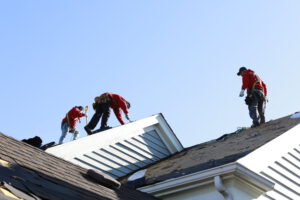Residential Roofing is typically constructed of A-frame trusses, plywood, decking, and shingles. Other roof accessories fit between the shingles and plywood decking, such as roofing felt, leak barrier, and drip edge. Residential roofing is typically installed in a day or two and requires ladders and fall protection harnesses for the workers.
When you’re constructing a new home, the roofing system is one of the most important parts of the building process. It requires permits and inspections, so it’s important to hire a licensed contractor. This way, you can be certain that the process is done properly. Depending on the location, you may also be required to have dormers installed or valleys added to roof planes.
The roof protects your home from harsh weather conditions. While there are several different types of roofing, the most common ones are the gable roof and the hip roof. You can make wise decisions by understanding the different styles and types available. Understanding your options will help you choose the right type of roof for your home.
There are many materials to choose from when roofing your home. Asphalt shingles, wood, metal, clay, glass, slate, and plastic, are all popular choices. The latter is a relatively new addition to the roofing industry and is made from engineered polymer and recycled materials. They can be crafted to mimic the look of slate tiles and cedar shake shingles and are quite durable.
PVC membranes are another popular choice for residential roofing. They are incredibly durable and are highly resistant to UV radiation and extreme weather conditions. Depending on how you want to install them, PVC membranes can mechanically or fully adhere to the roof deck. This material also offers good fire resistance. Some membranes are even factory-applied with a protective coating for additional protection. New environmentally-friendly roofing options are also being explored, including green roofing and solar panels. Moreover, many homeowners are now opting for roof gardens on flat roofs. These green roofs can add to the aesthetic appeal of the home and also reduce energy consumption.
Aside from asphalt shingles, you can also choose slate or composite shingles for your roof. Slate roofing is one of the more expensive choices, but it is very fireproof and eco-friendly. Moreover, it offers good resale value. Another option is tile roofing. It is an attractive option that matches the architectural style of your home. There are several different types of tiles available, from clay to concrete, but fiber cement composite tiles are more affordable. Slate is a popular choice for upscale homes because it has a distinctive look.
Asphalt shingles are a low-cost option for traditional homes. Asphalt shingles are also easy to install and durable. You can also choose architectural asphalt shingles, which are thicker than the conventional three-tab variety. You can also choose to install a concrete tile roof, which is energy-efficient and extremely durable. These tiles can last up to 50 years, but they are very heavy.
Installing residential shingles is a big project that requires a lot of preparation. First, it is essential to clean the area where you plan to work. Also, you should move any yard furniture away from the house. You should also take into account the weather conditions. If you are installing shingles during the fall or winter, you should plan your work accordingly.
Before you begin laying the shingles, you should measure the length and width of each shingle and mark the roof where you will lay the starter course. Usually, the starter course will be about a one-half inch longer than the rest of the shingles. You can also mark the roof where you want to install the rest of the shingles.
You should take accurate measurements of the roof, as this will determine how many squares you need. A typical roof area is 40 feet long by 50 feet wide, so a roof of this size will need about two or three bundles. If you are unsure of the size of your roof, you can ask a hardware store employee to help you. Also, make sure you have adequate ventilation.
Depending on the weather conditions, there are several methods of installation. Among them are racking, vertical racking, and step shingling. In racking, you install shingles one column at a time, overlapping the top edge of the shingle below and creating a smooth barrier against water.
After the initial installation of the roof, a felt paper underlayment should be used to give the shingles something to stick to. This underlayment will also keep the roof waterproof. Once that is done, the next step is to install the new shingles, starting at the ridge and working downward. To complete the look of the roof, you need to install the edging shingles.